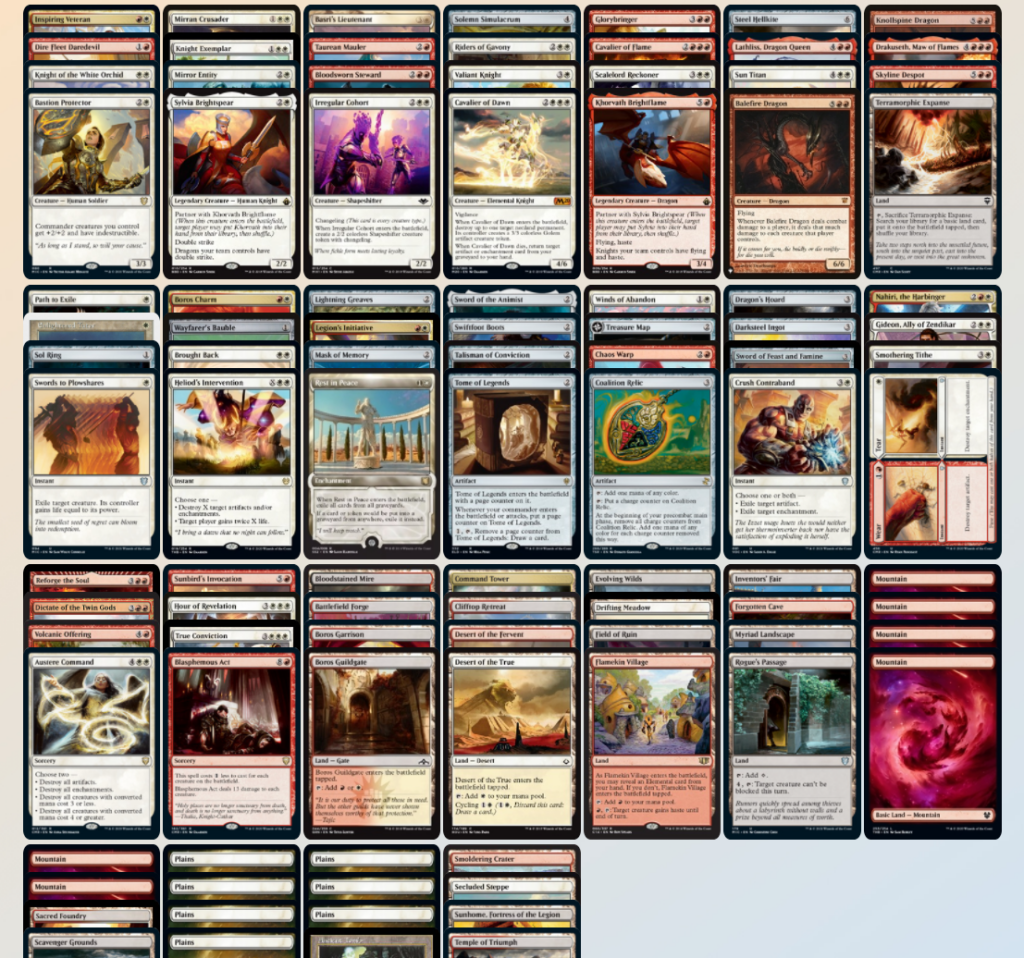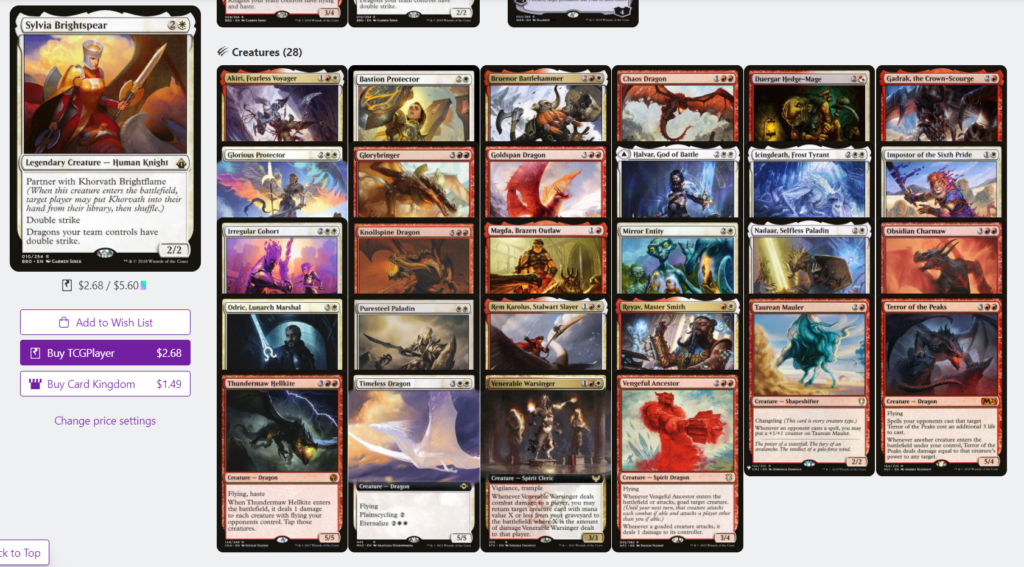What a Difference 2 Years Makes: Sylvia & Khorvath

If there’s one thing I can tell you as a lover of combat, it’s that Commander has changed a lot for “fair” aggro decks. We can all agree that outside of your regular playgroup (and perhaps even within it) games have gotten a little quicker, and decks tend to be “online” sooner than they used to.
I’d go as far as to say that playing six and seven mana-plus creatures outside of Green or dedicated Reanimator/Ritual style builds has become prohibitive unless you’re lucky enough to have cards like Ancient Tomb
Today I’d like to look at one of my decks and how it’s evolved to deal with a changing format.
Sylvia Brightspear & Khorvath Brightflame
When Sylvia & Khorvath were revealed in Battlebond, I knew I had to get my hands onto them. Boros partners that cared about two super flavorful tribes? I couldn’t say no. My original build of the deck concentrated equally on the better Knights and Dragons available, with a decent amount of ramp to get them into play, some great finishers like True Conviction

Sylvia and Khorvath were pretty popular partners back in 2018, and by 2019, I wasn’t the only one to have built them. The Legendary Creature podcast did a fun episode on Boros wherein they took a listener’s S&K deck and spiced it up with a Lin Sivvi, Defiant Hero
The problem with Sylvia and Khorvath as Commanders is that they only have keywords. Yes, they can grant them to the rest of your team, but in modern Commander, that’s about the least impressive thing you can have in the zone, especially when Boros is perpetually behind the latest Simic nonsense. Despite strong additions to the deck like Irregular Cohort
During 2020 I ended up dismantling my build. Aside from sourcing components for other brews, the reason I ended up dismantling the deck is because limiting myself to only Knights and Dragons didn’t afford me the better Boros creatures and spells, and ramping out into Dragons was proving to not really be worth it. Having Commanders without a combo or value - be that mana advantage or draw, or even extra combats - in the zone is a hard sell these days.
Adventures with Forgotten Decks
So, what drew me back in? Well, it was actually Adventures in the Forgotten Realms, interestingly enough. A set that I wasn’t particularly invested in as someone with only a passing interest in D&D, I was left to evaluate the cards as they were previewed to see if there was anything I was interested in. If you read my Set Review for White over at EDHREC, you’ll know I did enjoy the set. The card that reignited Sylvia and Khorvath for me was Nadaar, Selfless Paladin
It’s always telling about what you’ve previously played with when you identify a card that excites you, and in Nadaar’s case, there was a lot to love. First up, he was both Dragon and Knight, which immediately piqued my interest. Next up, he was low on the curve, and offered card advantage with the Dungeon mechanic. And to round things off, the +1/+1 buff to the team was exactly the reason I loved running Gideon, Ally of Zendikar
Sylvia & Khorvath 2: DragonSword
Every deck should have a great name, and so, as the year drew to a close, DragonSword was born. Before you ask, I’m not running Tastumasa, the Dragon’s Fang
So, DragonSword. What’s the message?
Well, having upgraded Syr Gwyn, Hero of Ashvale
The other great thing about equipment is that it allows you to lower your curve; you’re essentially building-your-own seven-drop, piecemeal, and you (in theory) get to keep some of it when it leaves play. The challenge comes in balancing utility and keywords; the best keywords in an equipment deck are Flying, Trample, Haste, and Doublestrike. You need at least one of the evasive abilities to get through, and you need Haste and/or Doublestrike to close out a game without having your board constantly removed leaving you unable to finish a game.
Thanks to the newer dragons printed this past year, I was able to flip the script. Dragons were now the bottom end of the deck, not the top end. They mostly cost me between three and five mana, and they mostly came with the exact keywords I’d want in an equipment deck: Flying and Haste.
Taking a page from the keyword soup decks – both Rograkh, Son of Rogahh
What Makes It Tick?

Now that I’d pivoted away from Knights, and focused on Dragons (and doublestrike) instead, there was now some space left in the deck left by absence of the Knights and “goodstuff” Boros cards.
The deck now has a new secret Commander: Magda, Brazen Outlaw
Of course, cheap equips and big buffs are the name of the game here. Heirloom Blade
Sylvia is such a good creature that some games it’s possible to start – or finish – with a Voltron approach. A 2/2 body isn’t the best, though, so getting a little bonus power is often enough to unlock attacks for her. Enter Radiant Grace
Lightning Spear, on the other hand, gives us trample for a cheap cost. This is crucial, as when we hit, we’re hitting hard. The opportunity to fire it off as removal is also pretty sweet, especially as it can make blocking really awkward for our opponents. We can always grab it back with recursion later.
Trample is pretty key, so aside from the Shadowspear
Now, given we’re already trying to do some tribal based stuff, we can’t go full-ham on equipment. Which is really no matter, as our dragons hit pretty hard with doublestrike on their own. Still, there’s redundancy in the deck. Reyav aside, we pack Halvar and True Conviction at our top end. Halvar is also sweet as he’s a rather good equipment on the other side, much like Icingdeath, Frost Tyrant
Meta-Calls
The price of Teferi’s Protection
Speaking of flicker, we’re running Sword of Hearth and Home
Rem is a meta call for sure, and one that could easily be replaced with another good equipment focused creature like Stoneforge Mystic
Speaking of boring, if you’re finding UGx value decks are able to race ahead too far, then Destructive Urge
Sylvia & Khorvath 2: DragonSword is a deck I’m having a lot of fun with. Indeed, it’s gotten me excited about playing Boros aggro again, which is a big relief. The format has changed a lot recently, and, rather than constantly upgrading a deck, switching gears for a rebuild is often the better answer. When most of your dragons can be hitting for anywhere from 12 to 20 damage per combat step, life totals drop quickly, leaving a very viable aggro deck for casual tables. Now, if they could just print some more three-mana Dragons…